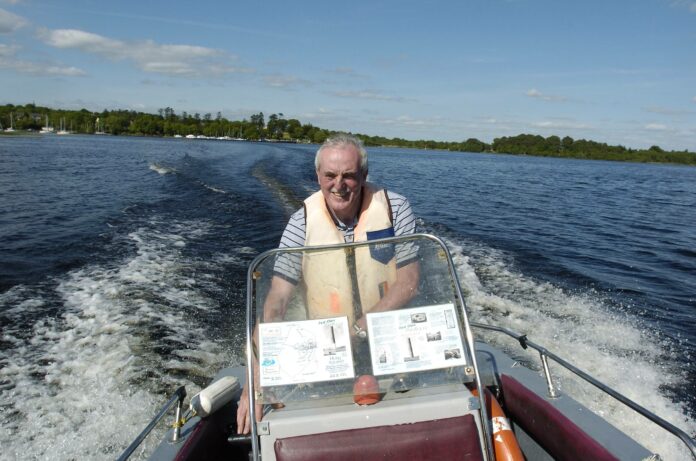LOUGH Derg and its Islands: A Voyage of Discovery by Road and by Water, is the latest publication by East Clare historian Gerard Madden and Tipperary man Shane Creamer.
The book will be launched this Saturday at 8.30pm in the Mountshannon Hotel by Éanna Rowe of Waterways Ireland and contains the only map of Lough Derg showing all the access points to the lake by road.
According to Gerard, to map out the whole lake to travel around it by road, you would need to buy three separate Ordinance Survey maps.
“This is the first time where you have one map of Lough Derg showing all the access routes to the lake,” he said.
It is also a great angling resource, as it names all of the known spots around the lake. The authors have also seen to it to name 376 of the islands on Lough Derg. To date, the Ordinance Survey Discovery Series only provides names for 113 of these islands.
Shane Creamer, who is the manager at Bank of Ireland in Scariff, is an angler from Portroe in County Tipperary. Gerard explained how the two came together to produce this 122-page publication.
“In 2009, Shane Creamer brought out a publication, which was an angling map of the fishing spots on Lough Derg, showing nearly all the local names. That started me thinking. I’d never heard of him before. I contacted him and since then we’ve had a great relationship. We decided we would do this. His map was based on a 1839 map, so we produced a completely new map. We now have 100 limited edition 4ft x 3ft copies of that map. It’s the first time that all these new angling places and new names for islands have been mapped,” he said.
He outlined that 376 islands have been listed for the first time and that the islands are one of the uniquely great things about the lake.
“Back in the 1920s, The Lakeside Hotel in Killole used to promote it as the lake of a thousand islands and it was a brilliant piece of advertising,” he said.
Gerard has always been interested in what lies beyond the next hill and, since his early 20s, the lake captured his imagination. He has spent 27 years making daily boat trips to Holy Island and a further 20 years before that on the lake where he enjoyed eel fishing. He has spent the past 10 years compiling this book and hopes it will be a good resource for tourists and locals alike who are interested in the lake, the angling points and looking to travel around Lough Derg.
“I was 21 years of age before I went to Holy Island. For three years I cycled past that place and I never knew what was in there. I have a degree in history and I taught for two years but I hated it. I found that I knew more about the American Civil War than I did about my own history. I used to be interested always in what was over the next hill. That always stuck with me,” he said.
In the book, Gerard has included all the folklore and history attached to the islands that he and Shane could find over the past 1,000 years, including poems and anecdotes.
“Shane is a fisherman first and foremost. He has fished all of the lake and he knows the names of all the new areas. These names are taken from various maps over the years. Every map that was ever done on Lough Derg we have examined it and every name has been included, the old with the new. Shane is responsible for all the new names. I think this is a book more for tourists travelling by road than by boat. The lake has never really been open. I used to drive around the lake before years ago and you would get lost because there is no signposting. All of the access points to the lake have been included in the book, so now everyone can drive around the lake and know what those access points are and where to go. That’s the first time that has been done. It will be a huge attraction, it’s a beautiful drive around the lake. It’s the first time in 175 years that the lake has been mapped,” he added.
Asked why this had not been done before, Gerard speculated that it is because the shape of the lake is complicated.
The Whitegate native said he thoroughly enjoys research and will spend much of the winter months in Dublin at the National Archives or online working on one project or another. “I love research. It’s never-ending. I’d have two or three books going at any given time,” he said.
Among the books he currently has in train is a book on the Famine workhouse in Scariff. “That will be out before Christmas. It’s from 1839 to 1851, a day-by-day account of the workers from contemporary reports and the papers. In 1849 there were 2,200 women in the workhouse and you can imagine that they were many of child-bearing age but every child born in the workhouse that year died. That was the report of a doctor at the end of the year,” he said.
The shocking details he uncovered of what took place during that horrific period in history will be covered in the book. He said the remnants of that awful time can still be seen in Tuamgraney today, at the memorial park.
“It is the most authentic memorial parks in the country because there are no modern headstones in it. It’s an acre of ground they bought in 1849 when all the other graveyards in Tuamgraney, Scariff and all around East Clare were full. It is known as the casaoireach, which comes from the words ‘cath siar iad’, meaning ‘throw them back’. There would be seven to eight thousand people buried there,” he said.
It has been documented that the workhouse at Scariff “was so overcrowded with paupers that a disease amounting to a plaque has broken out among its inmates” and the deaths numbered between four and 12 daily.
“It was horrific, they died in their hundreds, no one cared. Until 1996 this graveyard was overgrown. We cleared it and it’s a lovely place to visit now,” he said.
Another book in progress is on the stone bridges and roads of the Sliabh Aughties. Gerard is collaborating on this book with James Scully from Meelick, County Offaly and James will be chairing the launch event of the Lough Derg and its islands book this weekend.
“These bridges were built in the early 1800s and they were built for ass and carts and now there are timber lorries going over them and they are still there; some are in a bad way but they are still there. We have identified 200 of them and we are sketching about 50 of them. They are outdoor works of art with the workmanship that went into them. For something to built in the 1800s for ass and carts and now to have lorries going over them, who’d have thought of that,” he said.
The layout and design for the book has been provided by Mountshannon-based artist Paul Berg, who also collaborated with Gerard on another book, A brief history of Holy Island.
Lough Derg and its Islands: A Voyage of Discovery by Road and by Water will be available following the launch at Scéil Eile bookshop in Ennis, locally in Scariff and directly from Gerard.
A native of Ennis, Colin McGann has been editor of The Clare Champion since August 2020. Former editor of The Clare People, he is a journalism and communications graduate of Dublin Institute of Technology.


